Eon (Eon, 2) Read online
Page 4
There was dirt beneath one fingernail. He removed it with another fingernail.
If he could only explain the simple things—the figurine, the barbed wire used to string up the fence, the crate wood used to make the bridge over the moat—it would all fall into place.
The Stone would explain itself.
The only explanations he had now were much too incredible to be sane.
His comline hummed.
"Yes, Ann."
"Are you on duty now, Garry?"
"That I am."
"Transmission down the hole. OTV approach."
"Our savior?"
"I presume."
Hoffman had said this young woman was important, and the Advisor's word was one of the few things Lanier felt he could count on. In the four years since that night at the party, he had learned a great deal about politics in and out of world capitals, and how nations handled crises. He had come to realize how truly extraordinary Hoffman was. Capable, and with uncanny intuition.
But at that party, she had been dead wrong about one thing. The Stone's appearance did not signal the arrival of aliens, not in the strict sense of the word.
He picked up two slates and a processor. "Anything else?" he asked, standing by Blakely's desk.
"In and out," she said and handed him a cube of messages.
There was always a mild, cool breeze flowing down the almost vertical slope of the cap. Sometimes snow fell, piling up in drifts against the nickel-iron wall. The elevator entrance, a perfect semicircular arch, had been blasted out of asteroid material, as had all the tunnels, serviceways and bore holes of the Stone, by a fusion torch of extremely high power and efficiency. The sides of the short hall had been polished smooth and etched with acid by the Stoners to reveal the beautiful triangular Widmanstätten patterns, veined with rocky troilite intrusions.
The elevator was cylindrical, ten meters in diameter and five meters high, and was used for both personnel and freight. There were handgrips along the perimeter and tie-downs dimpled the floor. It followed a sloping tunnel to the staging areas surrounding the external bore hole. As the elevator climbed, its angular velocity declined, weakening the centrifugal force of the Stone's rotation. By the time it reached the vicinity of the bore hole, the spin produced only one-tenth of one percent g.
The trip took ten minutes. The elevator decelerated smoothly and stopped, its opposite hatch flush with a pressurized tunnel leading to the staging areas.
Taking an electric miner's cart, one of the two dozen or so brought up from Earth, Lanier rose most of the remaining distance along a magnetic rail.
The cart whined to a stop and Lanier drifted the rest of the way, pulling himself along guide ropes.
The first landings in the bore hole had been tricky. There had been no power to the rotating docks at that time, and very little illumination. The OTV pilots had proved their skill again and again. The first spacesuited explorers had shown great courage in leaving their craft and approaching the bore-hole walls, which rotated at about three-quarters of a meter per second. Now that the dock and staging area equipment had been refurbished and brought back into operation, the transfer process was much easier.
The three docks were simple, massive and efficient. Cylinders within the hole rotated to compensate for the Stone's spin, each accelerated like the rotor in a giant electric motor. One engineer in a booth below the prime dock controlled all of the docks, opening and closing hatches, coordinating cargo and passenger unloading.
The staging areas themselves had been thoroughly customized by the engineering team, outfitted with near-freefall workshops and machine shops. Here was where bulky cargoes were checked out, repackaged and either shipped down the elevators to the valley floor or flown along the axis to the next hole and chamber down the line.
The director of the engineering team, Lawrence Heineman, was talking to a slight, dark-haired young woman in the prime dock staging area as Lanier pulled himself in. They stood in a broad oval of light, hands on guide ropes, watching as large vacuum doors slid across to reveal the OTV's cocoon cargo resting on joists. The cargo dwarfed them.
Heineman, a short, crew-cut, muscular aerospace technician from Florida, smiled broadly and waved his hands, explaining something to the young woman. As Lanier approached, Heineman turned, held out the palm of one hand and bowed slightly in his direction. "Patricia, this is Garry Lanier, the closest thing to a civilian boss we have. Garry, Miss Patricia Luisa Vasquez." He shook his head and blew his breath out with an enthusiastic "Whoo!"
Lanier shook Vasquez's hand. She was small and pretty in a fragile way. Round face, silky dark brown hair, thin wrists, narrow legs, broad hips for her size: an altogether unpractical-looking woman, he thought. Beneath wide square eyes as black as his own, and a small, sharp nose, she had drawn her mouth into a tight line. She looked scared.
"My pleasure," Lanier said. "Larry, what have you told her so far?"
Heineman parried the question with a sidelong glance. "Patricia, I'm only a blue-badge for now—and I hear you're going to get a green. Garry is worried I might pass along some of the ignorant suppositions of an axis-hugger. I've only been telling her about this level of operations, I swear." He held up his right hand and clapped his left to his chest. "Garry, I've read some of this lady's papers in a half-dozen math and physics journals. She's fantastic."
There was a question on his face, however, which Lanier had no trouble interpreting. What in hell is she doing here?
"So I've heard." He pointed at the cocoon. "What's that?"
"My ticket to a green badge, finally," Heineman said. "Packing slips say it's the tuberider. And the V/STOL is coming in on the next OTV, a few hours from now."
"Then let's get it unwrapped and see what sort of modifications we'll have to make."
"Right. Pleased to meet you, Patricia." Heineman started to leave, then stopped and turned back slowly with a puzzled expression. "What you write about, it's really more a hobby for me, way beyond my expertise." He raised his eyebrows hopefully. "Maybe we can talk more later, though, when I get my green badge?"
Patricia smiled and nodded. Teams of men and women in gray jumpsuits were already gathering around the cocoon like ants tending a queen. Heineman joined them, calling out orders.
"Miss Vasquez—" Lanier began.
"Patricia's fine, really. I'm not very formal."
"Neither am I, if I can help it. I'm the science team coordinator."
"So Mr. Heineman told me. I have so many questions. . . Mr. Lanier, Garry, is this really a spaceship, a starship, the whole thing?" She swung her arm wide, her feet lifting from the deck momentarily.
"It is," he said, feeling the familiar, peculiar pleasure. Even though the Stone had nearly driven him crazy in the past few years, with its endless layers of surprise and shock, he was still more than a little in love with it.
"Where did it come from?"
Lanier held up his hands and shook his head. Vasquez suddenly noticed how exhausted he appeared, and that subdued her excitement some.
"First, I'm sure you'll want to rest and get cleaned up. Our facilities in the valley—the chamber floor—are quite nice. Then you can visit our cafeteria, meet a few of the team scientists, take it from there. One step at a time."
Vasquez examined him intently. Her eyes made the inspection seem less than sympathetic, even aggressive. "Is something wrong?"
Lanier raised his brows and glanced to one side. "We have a name for what this place does to you. We call it getting Stoned. I'm just a little Stoned, is all."
She looked around the staging area and experimented with the centrifugal force, pushing herself up a few centimeters with a nudge of her toe. "It looks so familiar," she said. "I expected an alien artifact to be mysterious, but I can identify almost everything, like it was built on Earth, by us."
"Well," said Lanier, "Heineman and his people have been busy up here. But keep an open mind. If you'll follow me, we'll descend to the floor of the firs
t chamber. Use the ropes. And if Larry hasn't already said it, allow me to welcome you to the Stone."
Chapter Three
Patricia lay on the air mattress, keeping still so the synthetic fiber sheets wouldn't squeak against the vinyl. Surrounded by darkness, she was clean, warm, well fed—the cafeteria food had been more than palatable—and now that she wasn't walking around, not nearly so breathless. Tired but unable to sleep. Her memory kept tossing up visions:
The thirty-kilometer-wide chamber floor, a mottled gray-and-brown valley landscape, capped at each end by impassive rock and natural metal walls, run through by the glowing plasma tube.
The peculiar perspective as she stood outside the valley level zero elevator entrance, facing the immensity, the landscape for kilometers around looking flat and normal, a desert on a bright cloudy day. Off to either side, however—spinwise and counter-spinwise—the curve became more pronounced. She seemed to stand under a vast arching bridge with the plasma tube a bright milky river flowing overhead. Directly north, the land rose to curve in snug conformity with the circular cap. Looking up, everything distorted as if seen through a fish-eye lens, the cap accepted the embrace of the opposite side of the chamber, completing the circle behind the plasma tube.
The Stone was still active, even though these chambers had been deserted centuries before.
Lanier hadn't answered many questions, telling her it was "the process" to let her see and experience the Stone, step by step. "Otherwise," he had said, "why should you believe what we tell you?" That made sense, but she was still frustrated. What was so mysterious? The Stone was magnificent and startling, but not—so far as she could tell—anything to arouse her professional interest. Straightforward physics, however advanced.
It was simple, really. Take one large asteroid, rock with a core of nickel-iron—your average billennia-old chunk of primordial planet-stuff—and push it into an orbit around your planet. Hollow out seven chambers, each connected by an axial bore hole, then worm-hole some of the remaining volume with tunnels, accessways, storage depots and elevators. Bring up supplementary carbonaceous and ice-volatiles asteroids and begin transferring their material into the chambers. Send it on a journey into deepest space, and voila!
The Stone.
She had learned a few key facts so far. Each chamber floor was connected by tunnels dug through the intervening asteroid material. Many of the tunnels were part of an extensive train transport system. There were no trains in the first chamber because it had served as a reserve and storage area and had been infrequently visited in the time when the Stone was populated. The seventh chamber had apparently served a similar purpose, which made sense—the outermost chambers doing double duty as buffers against damage to the comparatively thin ends of the asteroid. The wall between the first chamber cap and space was only a few kilometers thick in places.
But there was something peculiar about the seventh chamber. She had felt it in Lanier's voice and seen it in the expressions of those she had met in the cafeteria. And there had been the rumors on Earth. . .
Somehow, the seventh chamber was different, important.
She had met five team scientists so far, three in the cafeteria: Robert Smith, tall and bird-boned with red hair and down-angled eyes that made him seem sad, an expert on asteroid formation; Hua Ling, the slender and intense senior member of the Chinese team and a plasma physicist who spent most of his time at the south polar bore hole; and Lenore Carrolson, a round-faced woman of fifty with gray-blond hair and a permanently friendly, sensual expression, heavy-lidded eyes surrounded by smile lines.
Carrolson had greeted Patricia with motherly solicitude. It had taken Patricia several minutes to realize that this was the Lenore Carrolson, Nobel laureate, the astrophysicist who had discovered and partly explained gemstars eight years before.
Carrolson had taken Lanier's hint that it was her duty to show Patricia the women's quarters in the compound. They were in a long, fiberwall barracks on the north end of the quadrangle. The rooms were small and spare but comfortable in their own ingenious ways, everything lightweight and compact. In the building's lounge, Carrolson had introduced her to two other astronomers, Janice Polk and Beryl Wallace, both from the Abell Array in Nevada. They sprawled on couches that looked as if they had been assembled out of scrap metal in a high school shop class. Polk resembled a fashion model more than Patricia's image of an astronomer. Even in a jumpsuit, her dark beauty was elegant and distant, her expression not so much disapproving as skeptical. Wallace was attractive enough, but about twenty pounds overweight. She seemed perturbed about something.
Carrolson had pointed out the social roster located near the main door. "There are thirty women here on the science team, and sixty men. Two married couples, four committeds—"
"Five," Patricia had added.
"And six married but spouses back on Earth. I'm one of those. That means slim pickings for the single men. But committed or not, you're fair game if you put your name on the roster. There's an old saying that has to be bent a bit here: 'Don't dip your pen in the office ink.' Since office ink is all there is, some pen dipping is inevitable. But nobody has to take abuse." Carrolson glanced at Polk and Wallace. "Right, girls?"
"Paradise," Polk said flatly, looking up from her slate and widening her eyes. "Better than university."
"Any trouble," Carrolson said, "and you just tell me. I'm senior female here, in age at least."
"I'll do fine," Patricia had replied.
She had never been a social butterfly, tending to fall hard and fast—and usually without reciprocation. Still, with Paul to think of, that was the least of her concerns here. Although—and she smiled in the darkness—Lanier was a pretty fellow. So worried, though.
Patricia wondered if she would look just as worried when she had the whole picture.
Without knowing she had slept, she heard the chiming alarm on her comline. Beside her bed, a pleasant amber light switched on with the signal. She blinked at the bare, off-white walls and had no trouble remembering where she was. She felt right at home, in fact, and a little excited. She swung her feet over the edge of the bed.
Patricia had never been adventurous. Hiking and camping had not been missing from her life, but she had never felt inclined toward outdoor activities other than bicycling. Every six to eight months, she became an avid bicyclist, spending two hours each day riding around the campus. The urge would pass after several weeks and her sedentary habits would return.
There had always been too much to do in her mind or on paper. The mindwork could be done almost anywhere, but not while climbing precarious trails or being dead tired after a long march.
But here. . .
Sometime in the night, she had made the Stone her meat and drink. She was familiar with the feeling, having approached math problems with similar zeal. She was exhilarated, her pulse was up and she colored like a young girl.
When Lanier knocked, she had dressed and combed her hair. She opened the door with eyes wide.
Carrolson stood behind him. "Breakfast?" Lanier asked. Wearing the standard zipper-and-button blue jumpsuit of the science team, she looked more practical, he thought.
The clear pale light of the plasma tube never varied and cast only the vaguest of shadows beneath their feet as they walked. The cafeteria, adjacent to an experimental agricultural station, was feeding breakfast to the 1500–2400 shift. "Night" for Patricia had been from six in the "morning" to two in the "afternoon." Lanier said he slept irregularly; Carrolson was just finishing her shift.
About twenty of the science team clustered around a video screen at one end of the cafeteria. Lanier joined them briefly, then came back while Carrolson and Patricia sat down with dinner and breakfast. An automatic chef produced trays of food, each segment at the proper temperature, each dish surprisingly tasty. A tap near the unit carried a sign announcing, "Genuine STONE water—an experience not to be missed. H2O from the stars!" The water was flat but not unpleasant.
Lan
ier gestured at the group around the screen. "Football," he explained. "Hunt and Thanh have patched into the bore-hole microwave and the outside array. Some commercial outfit is relaying a scrambled game to subscribers and we happen to be in the same section of the sky as the satellite. They've unscrambled the signal."
"Isn't that illegal?" Patricia asked casually, sorting out the bites on her tray.
"Height hath its privileges," Carrolson said. "Nobody will ever prosecute."
Fresh orange juice was available. Citrus trees prospered under the tubelight. The maple syrup on her pancakes was also genuine, but not homegrown. Lanier noticed her expression of surprise.
"What we can't grow in the Stone, we might as well ask for the best from Earthside. It's so expensive to ship up anyway, quality only hikes it a fraction of a percentage point—and we have them convinced we should be fed at least as well as submariners and lunar settlers. Eat hearty—that's a two-hundred-dollar breakfast."
Carrolson chatted amiably through the meal, talking about her husband's work on Earth—he was a mathematician employed by the U.S. Office of Science and Technology. Lanier said little. Patricia was also quiet, taking her cues from him, watching him from the corner of her eye whenever she thought no one would notice. His Indian features attracted her, but the dark circles under his eyes made him look as if he hadn't slept in weeks.
"—really good for you," Carrolson was saying.
Patricia regarded her blankly.
"The tubelight, you know," Carrolson reiterated. "Has everything we need, and nothing harmful. You could lie out under it for days and not be burned, but you'd get your share of vitamin D."
"Oh," Patricia said.
Carrolson sighed. "Garry, you're having that effect again."
Lanier seemed puzzled. "What effect?"
"Look at the girl." Carrolson drummed her fingers on the lightweight metal table, rigged out of OTV tank baffles, as was so much furniture in the compound. "Watch out for him, Patricia. He's a heartbreaker."
Patricia glanced between them, mouth open. "What?"

 Foundation and Chaos
Foundation and Chaos Halo: Silentium
Halo: Silentium Blood Music
Blood Music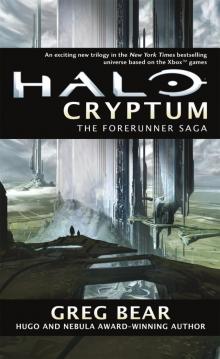 Halo: Cryptum
Halo: Cryptum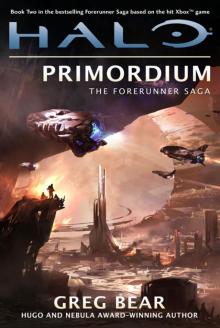 Halo: Primordium
Halo: Primordium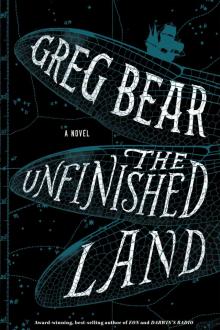 The Unfinished Land
The Unfinished Land Hardfought
Hardfought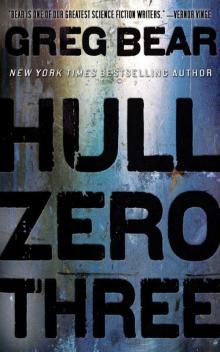 Hull Zero Three
Hull Zero Three Slant
Slant Multiverse: Exploring the Worlds of Poul Anderson
Multiverse: Exploring the Worlds of Poul Anderson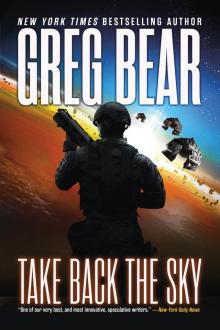 Take Back the Sky
Take Back the Sky Nebula Awards Showcase 2015
Nebula Awards Showcase 2015 Machineries Of Joy
Machineries Of Joy A Martian Ricorso
A Martian Ricorso Eternity
Eternity Vitals
Vitals The Infinity Concerto
The Infinity Concerto Beyond the Farthest Suns
Beyond the Farthest Suns Moving Mars
Moving Mars Quantico
Quantico Darwin's Radio
Darwin's Radio Beyond Heaven's River
Beyond Heaven's River Star Wars - Rogue Planet
Star Wars - Rogue Planet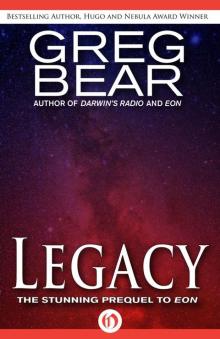 Legacy (Eon, 1)
Legacy (Eon, 1) War Dogs: Ares Rising
War Dogs: Ares Rising Sisters
Sisters Dead Lines
Dead Lines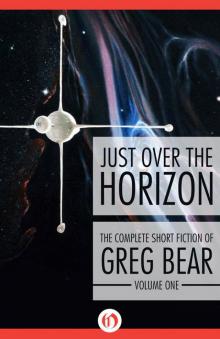 Just Over the Horizon (The Complete Short Fiction of Greg Bear Book 1)
Just Over the Horizon (The Complete Short Fiction of Greg Bear Book 1) Eon (Eon, 2)
Eon (Eon, 2) Venging
Venging Eon
Eon City at the End of Time
City at the End of Time Psychlone
Psychlone Dead Lines, A Novel of Life... After Death
Dead Lines, A Novel of Life... After Death Eternity (Eon, 3)
Eternity (Eon, 3) Cryptum
Cryptum Corona
Corona Sleepside: The Collected Fantasies
Sleepside: The Collected Fantasies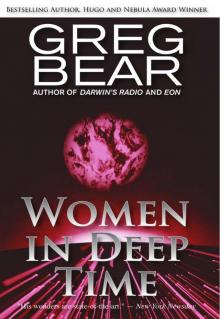 Women in Deep Time
Women in Deep Time Queen of Angels
Queen of Angels Darwin's Children
Darwin's Children Dinosaur Summer
Dinosaur Summer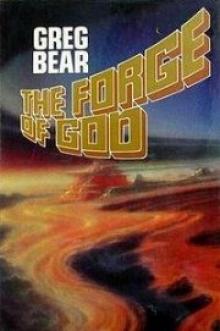 The Forge of God tfog-1
The Forge of God tfog-1 Foundation and Chaos f-9
Foundation and Chaos f-9 Star Wars: Rogue Planet
Star Wars: Rogue Planet The Forge of God
The Forge of God Mariposa
Mariposa Halo: Cryptum: Book One of the Forerunner Saga
Halo: Cryptum: Book One of the Forerunner Saga Strength of Stones
Strength of Stones Anvil of Stars
Anvil of Stars B00AQUQDQO EBOK
B00AQUQDQO EBOK Anvil of Stars tfog-2
Anvil of Stars tfog-2 Ares Rising 1: War Dogs
Ares Rising 1: War Dogs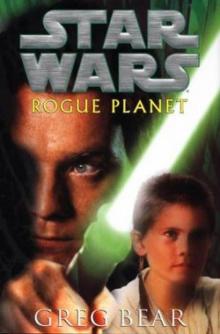 Rogue Planet (star wars)
Rogue Planet (star wars) The Machineries of Joy
The Machineries of Joy Far Thoughts and Pale Gods
Far Thoughts and Pale Gods Songs of Earth and Power Omnibus
Songs of Earth and Power Omnibus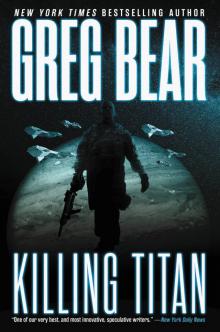 Killing Titan
Killing Titan Darwin's Radio d-1
Darwin's Radio d-1 Darwin's Children d-2
Darwin's Children d-2